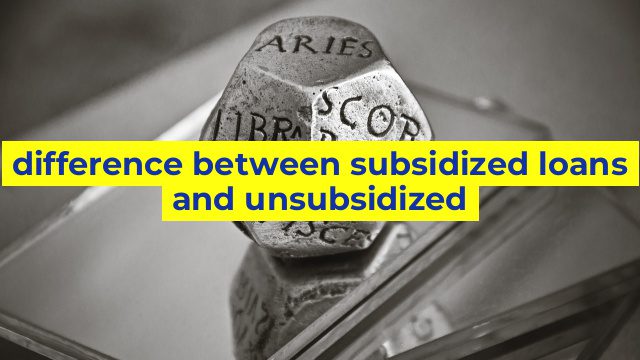Difference between Subsidized Loans and Unsubsidized Loans
Are you on the lookout for financial aid for your higher education? The good news is that you have a range of options to choose from, including subsidized loans and unsubsidized loans. However, before you decide which type of loan to apply for, it is important to understand the difference between the two.
What is Subsidized Loan?
A subsidized loan is a type of loan that is offered to students who have demonstrated financial need. The interest on the loan is paid by the government while you are studying, for a grace period after graduation and during certain periods of deferment. This means that as a borrower, you will not have to worry about accumulating interest on the principal amount during these periods.
What is Unsubsidized Loan?
An unsubsidized loan, on the other hand, is a type of loan that is not based on financial need. The student borrower is responsible for paying the interest that accrues on the loan from the time the loan is disbursed. This implies that you could end up with a higher debt amount by the time you graduate since interest has accumulated on the principal amount.
Key Differences between Subsidized and Unsubsidized Loans
– Eligibility: Subsidized loans are only offered to borrowers who demonstrate financial need, while unsubsidized loans are available to all students regardless of financial need.
– Interest: In subsidized loans, the government pays the interest on the loan amount while the student is in school, for a grace period and during certain periods of deferment. In contrast, interest accrues and accumulates throughout the life of the loan in unsubsidized loans.
– Maximum Loan Amount: The maximum loan amount for subsidized loans is based on your financial need, while the maximum limit on unsubsidized loans is higher as they do not take into account financial need.
Conclusion
When it comes to the choice between subsidized loans and unsubsidized loans, it’s important to consider your financial situation and repayment capacity. While subsidized loans offer lower debt amounts and easier repayment terms, unsubsidized loans are more flexible and offer more money. Do your research, and choose the loan that fits your needs best.
Table difference between subsidized loans and unsubsidized
| Subsidized Loan | Unsubsidized Loan | |
|---|---|---|
| Definition | A type of federal student loan based on financial need that doesn’t accrue interest while the borrower is in school at least half-time or during deferment periods. | A type of federal student loan that’s available to all eligible undergraduate and graduate students, regardless of financial need. Interest accrues on this loan from the time the loan is disbursed. |
| Interest Rate | Fixed interest rate of 3.73% for undergraduate loans and 5.28% for graduate loans (for loans disbursed on or after July 1, 2021) | Fixed interest rate of 3.73% for undergraduate loans and 5.28% for graduate loans (for loans disbursed on or after July 1, 2021) |
| Financial Need | Borrower must demonstrate financial need as determined by the Free Application for Federal Student Aid (FAFSA). | Not based on financial need |
| Repayment | Repayment begins six months after the borrower graduates, leaves school or drops below half-time enrollment. There is no interest charged during the in-school period and during authorized periods of deferment. | Repayment begins six months after the borrower graduates, leaves school or drops below half-time enrollment. Interest is charged during the in-school period and during authorized periods of deferment. |


